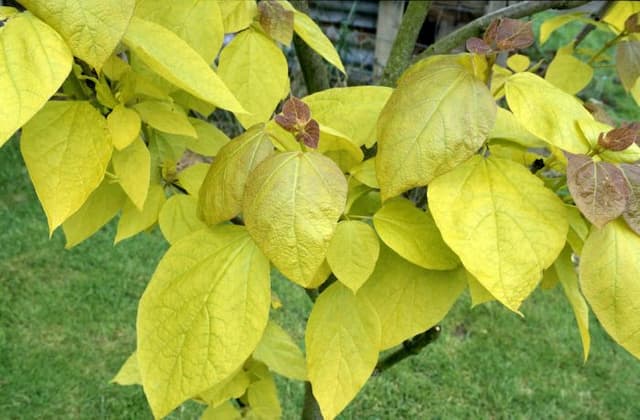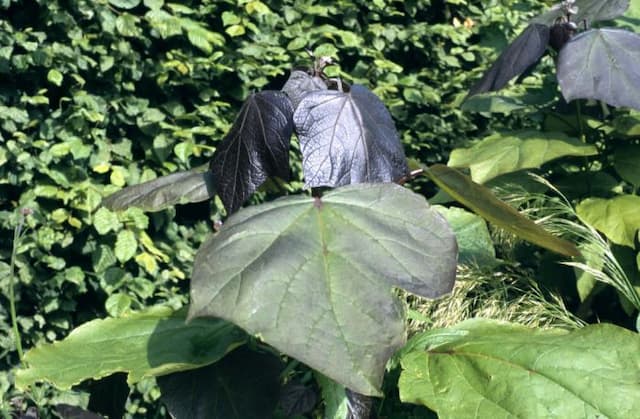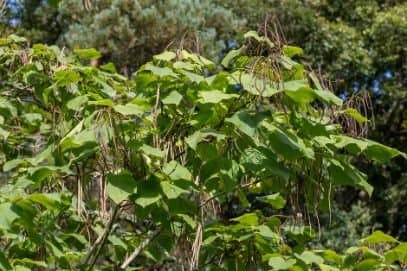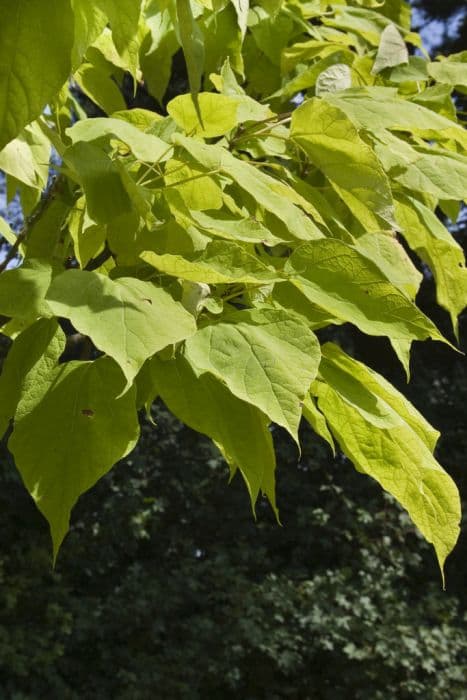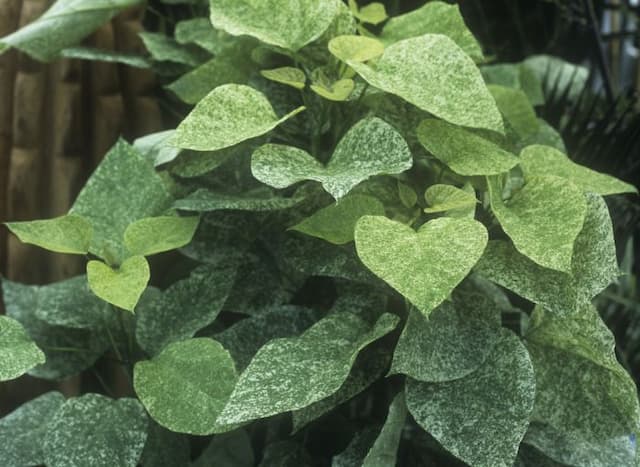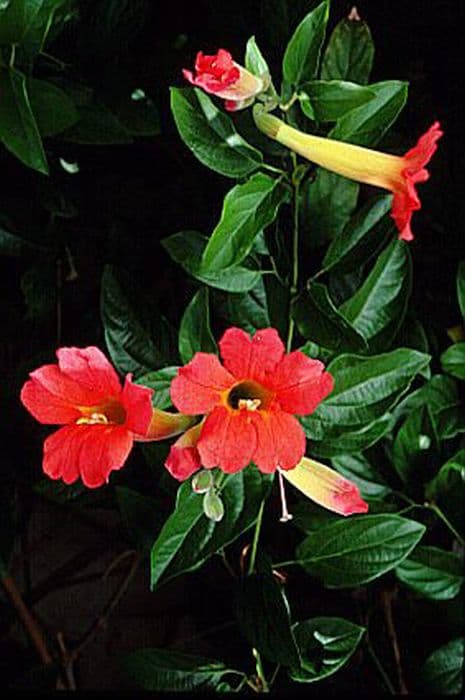Cape Honeysuckle Tecoma capensis

ABOUT
The Cape honeysuckle is an evergreen shrub that is well-known for its showy flowers and vigorous growth. Its leaves are glossy with a deep green hue, presenting an oval shape with pointed tips. The foliage provides a lush background for the vibrant flowers that bloom profusely throughout the growing season. The flowers themselves are tubular and flare out into a five-lobed shape, resembling small trumpets. They are most commonly a fiery orange color, but they can also be found in shades ranging from yellow to deep red. The blossoms grow in clusters at the ends of branches, creating a striking display that attracts many pollinators, including hummingbirds and butterflies. The branches of the Cape honeysuckle are somewhat scrambling, and the plant can take on a trailing habit, which makes it a good choice for use on slopes or to cover unsightly areas. When not in bloom, the plant maintains its visual appeal through its dense and green foliage. This hardy shrub can adapt to various conditions and can be pruned to maintain a desired shape or trained to climb up supports, allowing it flexibility in landscape design.
About this plant
 Names
NamesFamily
Bignoniaceae
Synonyms
Cape Honeysuckle, Cape Trumpet, Trumpet Vine
Common names
Bignonia capensis, Gelseminum capense, Tecoma petersii, Tecomaria capensis, Tecomaria krebsii, Tecomaria petersii.
 Toxicity
ToxicityTo humans
Cape honeysuckle is not widely recognized as a poisonous plant to humans, and there are limited reports of its toxicity. However, as with many plants, it is always prudent to exercise caution and avoid ingesting plant material unless it is known to be safe. If any part of the plant were ingested in significant quantities, it could potentially cause gastrointestinal distress or an allergic reaction in some individuals. If you suspect poisoning from Cape honeysuckle, seek medical attention.
To pets
Cape honeysuckle is not typically listed as a toxic plant to pets, but as with any plant, it can cause gastrointestinal upset if ingested in large quantities. Symptoms might include vomiting, diarrhea, or drooling in dogs and cats. If you suspect your pet has ingested part of this plant and is showing symptoms, it is best to consult a veterinarian.
 Characteristics
CharacteristicsLife cycle
Perennials
Foliage type
Evergreen
Color of leaves
Green
Flower color
Orange
Height
6-10 feet (1.8-3 meters)
Spread
6-10 feet (1.8-3 meters)
Plant type
Shrub
Hardiness zones
9
Native area
South Africa
Benefits
 General Benefits
General Benefits- Attracts Wildlife: Tecoma capensis, commonly known as Cape Honeysuckle, is known to attract birds, particularly hummingbirds, as well as beneficial insects like bees and butterflies due to its vibrant flowers.
- Aesthetic Appeal: With its bright orange to deep red flowers, Cape Honeysuckle adds a splash of color to gardens and landscapes, enhancing the visual beauty of the environment.
- Erosion Control: The plant can be used effectively for erosion control due to its fast-growing and sprawling habit, which helps stabilize slopes and banks.
- Drought Tolerance: Cape Honeysuckle is drought-resistant, making it a suitable choice for xeriscaping and water-wise gardens as it requires minimal supplemental watering once established.
- Privacy Screen: When grown as a hedge or shrub, it provides a dense screen that can be used for privacy or as a windbreak.
- Flexibility in Landscaping: Tecoma capensis can be trained to grow as a shrub or a climber, offering versatility in garden design and landscaping projects.
- Low Maintenance: It is relatively easy to care for, requiring little maintenance beyond occasional pruning to maintain its shape and encourage flowering.
 Medical Properties
Medical Properties- Antimicrobial: Tecoma capensis extracts have been studied for their antimicrobial properties against various strains of bacteria and fungi.
- Anti-inflammatory: The plant has been traditionally used to reduce inflammation, and some studies suggest it may have anti-inflammatory effects.
- Antioxidant: Tecoma capensis may have antioxidant properties due to the presence of phenolic compounds, which can neutralize free radicals and may have health benefits.
 Air-purifying Qualities
Air-purifying QualitiesThis plant is not specifically known for air purifying qualities.
 Other Uses
Other Uses- Cape honeysuckle vines can be trained to grow on fences or trellises to create a lush privacy screen or as a means to cover unsightly walls.
- The dense foliage of the cape honeysuckle plant can serve as a shelter for small birds who may nest within its branches.
- In coastal areas, cape honeysuckle is used to stabilize steep slopes, preventing soil erosion thanks to its extensive root system.
- The vibrant flowers of the cape honeysuckle can be used as a natural dye for fabrics, providing a sustainable coloring method.
- Its attractive blooms can be incorporated into floral arrangements as cut flowers, adding a touch of orange to bouquets and centerpieces.
- Cape honeysuckle can be kept in containers on balconies or patios, where it adds aesthetic value and attracts hummingbirds and butterflies.
- The arching form of the cape honeysuckle makes it an ideal candidate for creating living archways or tunnels in gardens and parks.
- Cape honeysuckle may be used as a companion plant in agriculture or home gardens to attract pollinators for food crops.
- Due to its quick growth and hardiness, cape honeysuckle can be used in reforestation projects to help restore native habitats.
- The plant's wood, although not commonly used, can be fashioned into small implements or used as fuel for campfires in rural settings.
Interesting Facts
 Feng Shui
Feng ShuiThe Cape Honeysuckle is not used in Feng Shui practice.
 Zodiac Sign Compitability
Zodiac Sign CompitabilityThe Cape Honeysuckle is not used in astrology practice.
 Plant Symbolism
Plant Symbolism- Resilience - Tecoma capensis, commonly known as Cape honeysuckle, is a tough plant that thrives in a variety of conditions, representing an ability to adapt and persist through life's challenges.
- Attraction - With its bright and vivid flowers, the Cape honeysuckle symbolizes attraction, suggesting that one can draw in positivity and good energy.
- Renewal - The plant has a vigorous growth habit and can recover from pruning or damage, symbolizing renewal and the capacity for growth and recovery.
 Water
WaterCape honeysuckle (Tecoma capensis) prefers consistent moisture and should be watered deeply once a week, allowing soil to dry slightly between waterings. During hot, dry periods, increase watering to twice a week, providing about 1-2 gallons of water each time depending on the size of the plant. It's essential to avoid waterlogging, so ensure good drainage to prevent root rot. In winter, reduce watering to every other week if rainfall is scarce.
 Light
LightCape honeysuckle thrives in full sun to partial shade. For best flowering, place it in a spot where it will receive at least 6 to 8 hours of direct sunlight each day. If grown indoors, a south-facing window is ideal to provide the bright light necessary for vigorous growth and bloom.
 Temperature
TemperatureCape honeysuckle prefers warm temperatures, with ideal growing conditions between 50°F and 80°F. It can tolerate minimum temperatures down to 30°F, but it is frost-sensitive and should be protected if temperatures dip below freezing. The plant may go dormant if exposed to prolonged cold but can recover when the temperature rises.
 Pruning
PruningPruning Cape honeysuckle is important to maintain its shape, remove dead or diseased wood, and encourage bushier growth with more flowers. Prune in late winter or early spring before new growth begins. Cut back the plant by about one-third of its size annually, and remove any crossing or wayward branches to enhance air circulation.
 Cleaning
CleaningAs needed
 Soil
SoilCape honeysuckle (Tecoma capensis) thrives best in well-draining soil, with a mix that could include equal parts of loam, sand, and compost to promote good drainage and fertility. The ideal pH for Cape honeysuckle is slightly acidic to neutral, ranging from 6.0 to 7.0. This balance will support healthy root and foliage growth.
 Repotting
RepottingCape honeysuckle should be repotted every 2 to 3 years to refresh the soil and accommodate root growth. It's best to repot during spring or early summer when the plant is actively growing. Ensure the new pot is only slightly larger than the old one to prevent overwatering.
 Humidity & Misting
Humidity & MistingCape honeysuckle prefers moderate to high humidity levels but is quite adaptable and can tolerate lower humidity. Although it thrives in outdoor environments with natural humidity, indoor humidity levels around 40-50% are generally suitable.
 Suitable locations
Suitable locationsIndoor
Grow Cape honeysuckle in bright light and well-draining soil indoors.
Outdoor
Plant Cape honeysuckle in full sun, well-draining soil, and space adequately.
Hardiness zone
9-11 USDA
 Life cycle
Life cycleTecoma capensis, also known as Cape honeysuckle, begins its life cycle with seed germination, which requires warm temperatures and moist soil conditions. The seed develops into a seedling, which grows rapidly due to the plant's vigorous nature. As the seedling matures into a juvenile plant, it develops a woody stem and a branching habit, with leaves arranged in opposite pairs. Once mature, Cape honeysuckle starts flowering, producing bright orange to reddish trumpet-shaped flowers that attract pollinators like birds and insects, leading to pollination and fruiting. The fruits are elongated capsules containing numerous small winged seeds, which are dispersed by wind. Finally, with adequate conditions, these seeds can germinate to complete the cycle, while the parent plant can live for many years, continuing to grow and bloom typically during the warmer months.
 Propogation
PropogationPropogation time
Spring to Summer
The most popular method of propagating Cape Honeysuckle (Tecoma capensis) is through semi-hardwood cuttings. This can be done in late summer or fall. Cut a healthy stem that is about 4-6 inches long, making sure it includes several sets of leaves. Remove the leaves from the bottom half of the cutting and dip the cut end into rooting hormone powder to enhance root development. Plant the cutting in a pot filled with a well-draining potting mix, and keep the soil moist but not waterlogged. Cover the pot with a plastic bag or place it in a humid environment to maintain high humidity around the cutting. Roots typically develop within a few weeks, after which the cutting can be gradually acclimated to less humid conditions and eventually planted outdoors.

